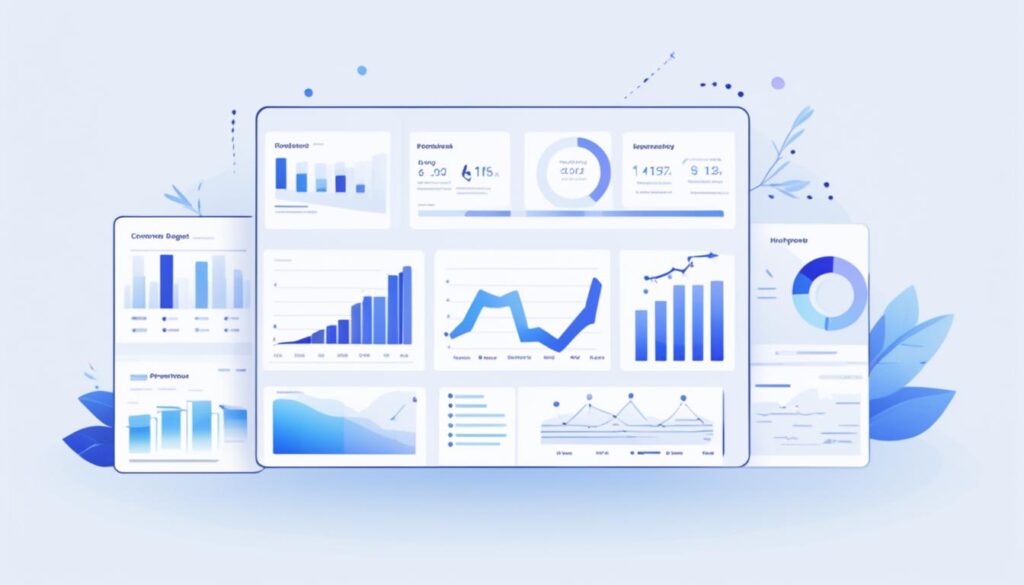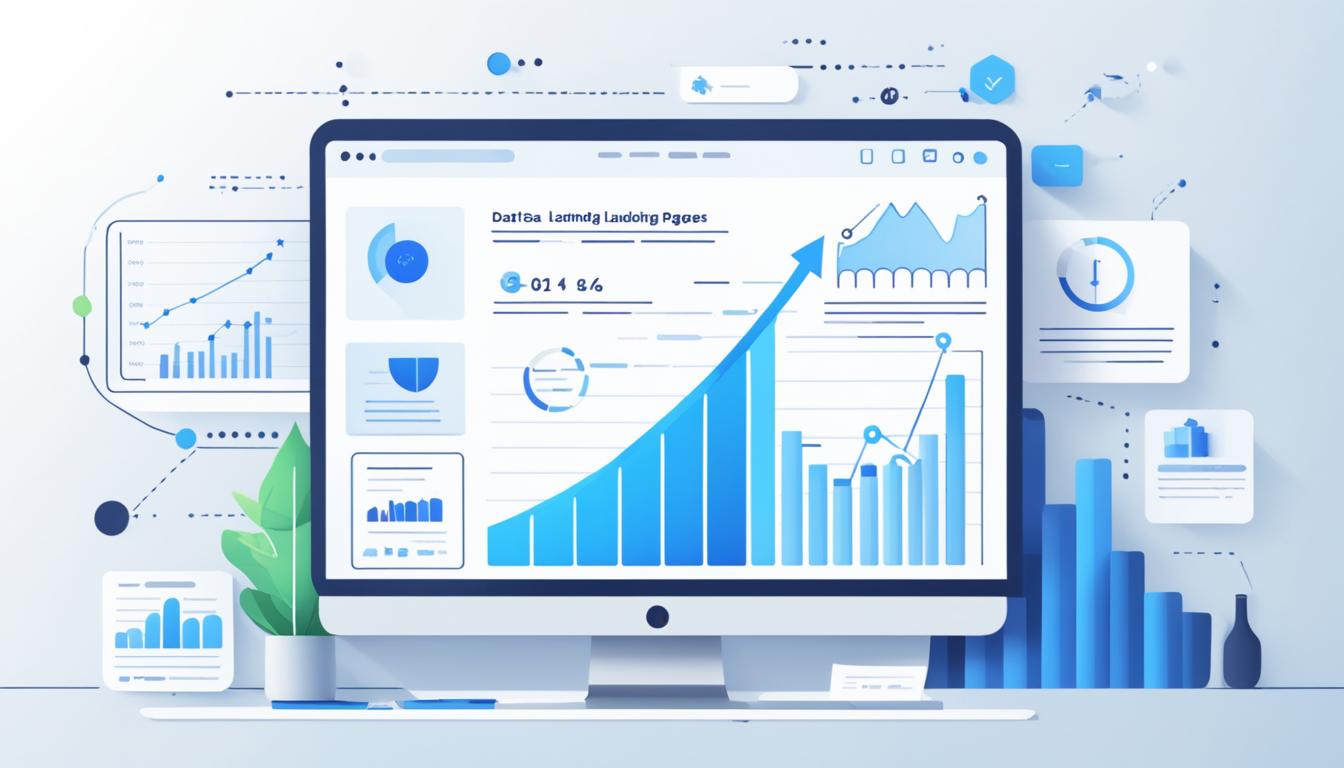Landing pages play a vital role in the success of any online business. They are the first point of contact between potential customers and your brand. To ensure maximum conversions and create an exceptional user experience, optimizing your landing pages is crucial. One effective approach is leveraging big data insights to make data-driven decisions that will enhance your landing page performance. By using big data, you can tailor your landing pages to be more targeted, engaging, and persuasive, leading to improved conversion rates.
When it comes to data-driven landing page optimization, there are various strategies and tools that can help you achieve desired results. This article will delve into key aspects such as understanding your audience, conducting effective testing, and implementing best practices to optimize your landing page conversion rates.
Key Takeaways:
- Using big data insights can optimize landing pages for increased conversion rates.
- Understanding your audience is crucial for effective landing page optimization.
- Conducting A/B tests and analyzing key metrics are essential for refining landing pages.
- Implementing best practices in headline creation, copywriting, and design can improve conversion rates.
- Leveraging data-driven strategies leads to landing page success.
By applying these insights, you can transform your landing pages into powerful conversion tools. Stay tuned for the next sections where we explore each aspect in detail to help you optimize your landing pages for success.
Understanding Your Audience for Effective Landing Page Optimization
To optimize your landing pages and achieve higher conversion rates, it is crucial to have a deep understanding of your audience. By gathering valuable insights about your customers, their needs, and motivations, you can tailor your landing pages to meet their expectations and create a personalized experience.
Start by defining the purpose of your landing page and the specific conversion goals you want to achieve. This clarity will help you align your messaging and design elements with these objectives.
When optimizing your landing pages with big data insights, consider the customer journey and adapt your content accordingly. By identifying what drives, convinces, and persuades users to take action, you can create landing pages that truly resonate with your target audience.
There are several methods to gather valuable audience insights:
- Surveys: Create well-designed surveys to collect information directly from your audience. Ask them about their preferences, pain points, and interests.
- Interviews: Conduct interviews with your existing customers or potential leads to gain deeper insights into their needs and motivations.
- Data analysis: Analyze your existing customer data and website analytics to understand user behavior patterns and preferences.
One effective way to understand your audience better is by creating detailed user personas. User personas are fictional representations of your ideal customers, based on real data and insights. They help you understand your audience’s demographics, goals, challenges, and preferences.
“By creating detailed user personas based on big data insights, you can craft landing pages that speak directly to your target audience, addressing their pain points and providing solutions that resonate with them.”
With a thorough understanding of your audience, you can implement data-driven strategies for higher conversion rates. By optimizing your landing pages with big data insights tailored to your specific audience segments, you will increase the chances of capturing their attention, engaging them, and ultimately converting them into valuable customers.

Key Takeaways:
“To optimize landing pages, understanding your audience is crucial. By gathering insights about their needs and motivations, you can tailor your pages, increasing your chances of converting visitors into customers.”
| Benefits of Understanding Your Audience for Landing Page Optimization: | Methods to Gather Audience Insights: |
|---|---|
| 1. Increased conversion rates | 1. Surveys |
| 2. Better user experience | 2. Interviews |
| 3. Personalized messaging | 3. Data analysis |
| 4. Higher engagement |
Conducting Effective Landing Page Testing
Testing is an essential component of data-driven landing page optimization. By developing an effective testing strategy, you can identify areas for improvement and optimize your landing pages for maximum conversions. A/B testing is a popular method that involves comparing different variations of headlines, copy, CTAs, and design elements to determine which combination drives the highest conversion rates.
One of the key aspects of conducting effective landing page testing is utilizing reliable conversion tracking tools such as Google Analytics and Hotjar. These tools provide valuable insights into key metrics such as click-through rates, bounce rates, and conversion rates, allowing you to measure the effectiveness of your landing page elements.
Continuously experimenting with different elements of your landing pages is crucial to uncover winning combinations that drive maximum conversions. By analyzing the data collected from your tests, you can make data-driven decisions to optimize your landing pages and achieve higher conversion rates.
The Benefits of Effective Landing Page Testing
Conducting effective landing page testing offers several benefits:
- Increased Conversion Rates: By identifying and implementing the most effective elements through testing, you can optimize your landing pages to drive higher conversion rates.
- Improved User Experience: Testing allows you to create landing pages that provide a better user experience, leading to increased engagement and conversions.
- Reduced Customer Acquisition Costs: By optimizing your landing pages, you can maximize the return on your advertising investment and reduce customer acquisition costs.
Remember, effective landing page testing is an ongoing process. Continuously monitor your landing page performance, gather data, and refine your strategies to ensure your landing pages are consistently optimized for conversions.

| Key Metrics | Conversion Rate (%) | Click-Through Rate (%) | Bounce Rate (%) |
|---|---|---|---|
| A/B Test Variation A | 18 | 22.5 | 55 |
| A/B Test Variation B | 21 | 17.2 | 38 |
Best Practices for Optimizing Landing Page Conversion Rates
To achieve optimal conversion rates on your landing pages, it’s essential to follow best practices that leverage big data and focus on data-driven landing page optimization. By implementing these strategies, you can effectively engage your audience, address their pain points, and drive more conversions. Here are some key practices to consider:
- Get to know your audience: Before you optimize your landing pages, it’s crucial to understand your target audience. Conduct thorough research and gather insights about their demographics, preferences, and motivations. This data will help you tailor your landing pages to their specific needs, increasing the chances of conversion.
- Create compelling headlines and persuasive copy: Your landing page headlines should grab users’ attention and clearly communicate the value of your offer. Use concise, persuasive copy that addresses their pain points and highlights the benefits of your product or service. Make sure the copy is easy to scan and understand, as visitors tend to skim through the content.
- Design visually appealing CTAs: Your call-to-action (CTA) buttons should stand out and be visually appealing. Use contrasting colors and compelling text to encourage users to take action. A well-designed CTA can significantly impact conversion rates.
- Use clean and engaging design: The visual appeal of your landing page plays a crucial role in capturing users’ attention. Implement a clean and modern design that aligns with your branding and focuses on highlighting your offer. Use high-quality images and videos to enhance user engagement.
- Integrate robust conversion tracking tools: To make data-driven decisions, it’s essential to have accurate insights into your landing page performance. Integrate robust conversion tracking tools, such as Google Analytics and Hotjar, to monitor key metrics like click-through rates, bounce rates, and conversion rates. This data will help you identify areas for improvement and optimize your landing pages effectively.
- Continuously test and experiment: Testing is a crucial aspect of landing page optimization. Continuously test different variations of elements like headlines, copy, CTAs, and design to identify winning combinations. A/B testing can provide valuable insights into what resonates with your audience and drives maximum conversions.

Implementing these best practices for optimizing landing page conversion rates will ensure that you’re making the most of your data and creating engaging experiences for your audience. By continuously refining and experimenting with different variations, you can achieve higher conversion rates and drive the success of your online business.
Conclusion
Optimizing your landing pages with data-driven insights is the key to achieving higher conversion rates and delivering an exceptional user experience. By understanding your audience, conducting effective testing, and implementing best practices, you can create landing pages that resonate with your target market and drive more conversions.
With data-driven landing page optimization, you can leverage valuable insights to tailor your messaging, design, and layout to meet the expectations and needs of your audience. By gathering data on customer behavior, preferences, and motivations, you can create landing pages that effectively engage and convert visitors into customers.
By continuously testing and experimenting with different elements of your landing pages, you can uncover winning combinations that drive maximum conversions. Use tools like Google Analytics and Hotjar to track key metrics and make data-driven decisions. Implement compelling headlines, persuasive copy, visually appealing CTAs, and clean design to captivate your audience and drive them towards taking action.
Take advantage of data-driven landing page optimization to unlock the full potential of your online business. By leveraging data insights, you can refine and optimize your landing pages for success, resulting in increased conversions and higher engagement. Start implementing these strategies today and witness the transformative power of data-driven landing page optimization.
FAQ
Why is landing page optimization important?
Landing page optimization is important because it helps improve web page design and layout to increase conversions and create a better user experience.
How can big data insights help optimize landing pages?
Big data insights can help optimize landing pages by providing valuable information about your audience, their needs, and motivations, allowing you to tailor your landing pages to meet their expectations.
What is the purpose of conducting A/B tests for landing page optimization?
A/B tests allow you to compare different variations of headlines, copy, CTAs, and design elements to identify areas for improvement and optimize your landing pages for maximum conversions.
What are some best practices for optimizing landing page conversion rates?
Some best practices for optimizing landing page conversion rates include getting to know your audience, creating compelling headlines and persuasive copy, designing visually appealing CTAs, and continuously testing and experimenting with different elements.
How can data-driven landing page optimization lead to increased conversion rates?
By understanding your audience, conducting effective testing, and following best practices, data-driven landing page optimization can create landing pages that resonate with your target audience and drive more conversions.








